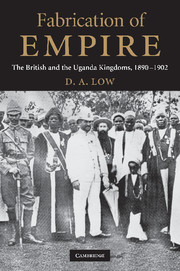Book contents
- Frontmatter
- Contents
- Preface
- List of abbreviations and locations
- Sketch maps
- 1 Prologue: survey and agenda
- 2 Statecraft: external intrusion and local dominion
- 3 Ferment: conversion and revolution in Buganda
- 4 Upcountry: might-have-beens and the Buganda/Uganda outcome
- 5 Warbands: new military formations and ground level imperialism
- 6 Paramountcy: Toro, Busoga and the new overlords
- 7 Defeat: Kabalega's resistance, Mwanga's revolt and the Sudanese mutiny
- 8 Succession: Nkore and the war of Igumira's eye
- 9 Dénouement: aggregations and rulerships
- 10 Government: colonial settlements and the Buganda model
- 11 Capstone: honour, awe and imperialism
- 12 Round up and review
- Select bibliography
- Index
6 - Paramountcy: Toro, Busoga and the new overlords
Published online by Cambridge University Press: 04 July 2009
- Frontmatter
- Contents
- Preface
- List of abbreviations and locations
- Sketch maps
- 1 Prologue: survey and agenda
- 2 Statecraft: external intrusion and local dominion
- 3 Ferment: conversion and revolution in Buganda
- 4 Upcountry: might-have-beens and the Buganda/Uganda outcome
- 5 Warbands: new military formations and ground level imperialism
- 6 Paramountcy: Toro, Busoga and the new overlords
- 7 Defeat: Kabalega's resistance, Mwanga's revolt and the Sudanese mutiny
- 8 Succession: Nkore and the war of Igumira's eye
- 9 Dénouement: aggregations and rulerships
- 10 Government: colonial settlements and the Buganda model
- 11 Capstone: honour, awe and imperialism
- 12 Round up and review
- Select bibliography
- Index
Summary
Back in February 1890 Stanley had told Mackinnon that, while it was possible to conquer Buganda, it was important to remember that it was ‘a big country, and the people tolerably good fighters’. Without a railway to cover at least part of the journey, it would take eighteen months and would require ‘500 picked Englishmen’, 2,000 porters and 1,000 mercenary troops. From the time of Lugard's first arrival, it did arguably take eighteen months before he effectively asserted his hegemony over Buganda, but that never required anything like an expeditionary force of the size which Stanley specified. The precursors which conditioned the circumstances which Lugard confronted, in which the consequences that flowed from Kabaka Mwanga's adoption of Kabalega's system of new model warbands played a major role, provided him with a situation which presented a far less formidable opposition than Stanley anticipated.
There were two other places where the establishment of British authority likewise turned, in the end, on the actions of new model warband leaders in their midst.
But what of those places where there had been no diffusion of the new model warband system?
There were two such close at hand – the Toro region to the west of Buganda, and the Busoga region to the east; ‘regions’ because both were made up of a miscellany of small, sometimes minuscule, rulerships, none of which was powerful enough to lord it over all the others.
- Type
- Chapter
- Information
- Fabrication of EmpireThe British and the Uganda Kingdoms, 1890–1902, pp. 150 - 183Publisher: Cambridge University PressPrint publication year: 2009



